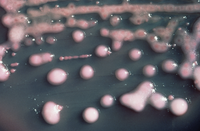
Photo from wikipedia
OBJECTIVES Since KPC-2-producing Klebsiella pneumoniae are associated with successful dissemination of a major clone, defined as sequence type 258 (ST258), the aim of this study was to perform whole-genome sequencing… Click to show full abstract
OBJECTIVES Since KPC-2-producing Klebsiella pneumoniae are associated with successful dissemination of a major clone, defined as sequence type 258 (ST258), the aim of this study was to perform whole-genome sequencing (WGS) of the first colistin-resistant K. pneumoniae strain (Kpn666) carrying blaKPC-2 identified in Uruguay in 2011 in order to identify genomic and phylogenetic traits. METHODS WGS of strain Kpn666 isolated from an asymptomatic urinary tract infection was performed using Illumina MiSeq, and de novo assembly was performed using SPADES v.3.11. Contigs were re-ordered using the ST258 reference genome NJST258_1 (GenBank CP006923) and were oriented with the MAUVE Contig Mover. Twenty complete genomes of K. pneumoniae identified as ST258 using the Pasteur MLST site were downloaded from GenBank (May 2017). A maximum-likelihood tree was created using MEGA7 based on core single nucleotide polymorphisms (SNPs) from whole-genome alignment obtained with SNP sites (https://github.com/sanger-pathogens/snp-sites). RESULTS WGS analysis revealed a genome of 5448179bp (5232 CDS, 108 RNAs). Phylogenetic analysis identified that Kpn666 belonged to clade I lineage of ST258. Further studies also identified IncR, IncFIB(K) and IncFII(K) plasmid replicons and 11 transferable associated antimicrobial resistance genes (ARGs) comprising four drug classes. The mgrB gene involved in colistin resistance was shown to be disrupted by insertion of an IS5-like element. CONCLUSIONS The first isolate of KPC-2-producing K. pneumoniae detected in Uruguay was sequenced and the results confirm the ability of this bacterium to capture several ARGs. The KPC-2 carbapenemase in Uruguay is likely to have been introduced by the high-risk clone ST258.
Journal Title: Journal of global antimicrobial resistance
Year Published: 2018
Link to full text (if available)
Share on Social Media: Sign Up to like & get
recommendations!